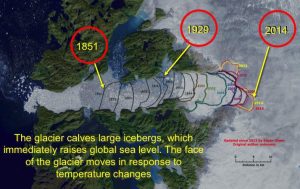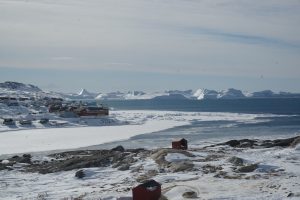Shocked This Glacier Calving Face is Now Gone

Massive well-defined calving face from the largest glacier in Greenland shown here in 2014 is now gone! It has receded so far, that it is now way up on the land. As a result the face is just a sloping ambiguous mass.
I am back in Greenland this week educating and escorting a group across the ice sheet. This group was organized by Active Philanthropy, based in Germany. The purpose is to show decision makers, first hand, how the world is changing in ways that few grasp. The idea is to support the urgency to change policies. The experience is powerful, in part because we have their undivided attention for a few days without the distractions of our usual lives. The other aspect is that nothing can describe the scale or enormity of the ice sheets and glaciers. It never fails to leave people speechless, sober, and reflective about how the world is changing in a very profound way.
Yesterday we went by helicopter to see the calving face of the largest glacier on Greenland – the clearly defined vertical facade where the big icebergs calve off. Historically it has been known by the Danish name Jacobshavn (“YOCK-obs-haf-en”) but now one of the native words is preferred, either the Ilulissat or Kanglia Glaciers. Regardless of what it is called, this is the dominant glacier of Greenland. Of the more than one hundred glaciers–the rivers of slowly moving ice– that lead to the sea, this is the big boy, carrying 6% of the total. It is estimated to put out enough water in a day to satisfy the water needs of New York City for a year.
Over the years coming here with leaders from the military and world of business and philanthropy I have been able to show where the giant icebergs calve off the vertical calving face and fall into the rubble strewn fjord below. The face was quite distinct as shown in the photo above from 2014. Note the helicopter circled near the base to show the scale.
The nearby community of Ilulissat has been there for centuries and has carefully tracked the retreat of the calving face as it moved inland starting back in 1851. The overhead satellite view here shows the retreat of the calving face up to 2014. It moved almost as much in the last decade as in the full century from 1850-1950. The main glacier mass is to the right up on the ice sheet. With the continued melting the calving face moves up the fjord, from left to right. Within the last few years the retreat moved the calving face up onto land.
Yesterday I realized that the face was now gone. At first I was confused and disoriented, but then it sank in, the distinct vertical face that we have come to visualize and track was not there anymore. Now it is just a gradually sloping pile of snow and ice, without any distinct definition. It makes sense that this would change as the melting progressed and moved the boundary up onto the land, but it happened so fast. The melting is continuing and accelerating, with meltwater still flowing to the fjord and the sea, underneath the ice.
Here in the village of Ilulissat, the enormous icebergs are really stunning as shown in this photo I took this morning. In fact in the local language, Greenlandic, spoken by the Inuit, the people of the Arctic, the word Ilulissat means iceberg. The natives named this place Illulissat because of the signature huge icebergs from this particular calving glacier. It would seem that we may be seeing the end of these mega-glaciers and icebergs from this fjord.
I am writing this on April 5th as we set out on the ice sheet by dog sled with local Inuit hunter guides. Traveling by dog-sled will be a first for me on Greenland. We will spend three days on the ice, camping. No doubt this experience for me will add further depth and insight into what is happening in this very special part of the world. Our visit here ends on April 9. I will do a follow up report about Greenland next week, trying to capture more of an overview of the dramatic changes here.


